Muleshoe has had rain for the last seven days- August tends to be our monsoon season-and during those times when the water wasn’t falling from the sky, that sky was gray and overcast; no sunshine, which means that all my cactus and succulents, potted and in the ground, are soppy wet.
And that is not necessarily a terrible thing, unless the plants in pots are sitting in water and the plants in the ground have poor drainage.
So I hope you provided good drainage for your outdoor plants in the ground by adding gravel to the soil when you planted them, or planting them on the side of a little berm or in an area that gradually slopes and allows for the runoff to travel away from the plant. Don’t plant in a low spot that will collect water.
Plants in pots without a drain hole will need to be tilted sideways as much as possible to let the excess water run out, and plants sitting in a saucer full of rainwater need to be set out of the saucer so the water can drain on its own and the plant won’t just sit in water for days until it finally evaporates. By the time the water is gone, your plant may have already begun to rot.
These pots were not sitting in a saucer, but the water continues to seep out even after the concrete has dried in between showers. They need the chance to do this so the soil can begin to dry out.
So now that I have you scared to death, let me assure you-all is not lost! Cactus and succulents may be drought-tolerant plants, but that doesn’t mean they don’t like water from time to time. What they don’t like is sitting in water for days on end, roots saturated and soggy, and that’s why you take pains to allow them to dry after the rain. They love the rain and will prove it by putting on growth spurts and looking fleshy and healthy, and blooming, if the timing is right. But when it rains for several days running without sunshine to dry them out, and collecting too much water that they can use effectively, you have to help by not letting them sit in water, and maybe even more importantly, by not watering them yourself before they have had time to dry out completely from all the rain.
Depending on the size of the pot and the soil and the weather and sunshine after the rain, that might take as long as a month, maybe even more. Leave them alone and they will gradually use up that moisture content and be happy as they do. One way to check if they are dry from top to bottom is to insert a bamboo skewer like you would use for shish-kabobs. If it comes out wet and sticky with dirt, don’t water. The pot in the picture below has a skewer inserted into the soil, a clean one for you to compare to a dirty one that I just pulled out of the pot. The one criss-crossing on top has a dirty tip.
It is hard to see that dirty tip, so I took a close-up to show you what it might look like if it is still wet. And those white spots on the astrophytum are not mealy bugs, but natural flocking that decorates the plant.
When the skewer comes out dry, then it would be safe to water again. But after being soaked from the rain, it wouldn’t hurt to wait several days before watering again. The plant will have stored lots of water already and is doing just fine without more for a while, thank you very much. Remember that in the wild, they may go many months without water.
I suppose you could use the skewer technique with your plants in the ground, but because they are in their natural environment and not captured in a pot, they are fine for quite a while without watering. I have no formula for you; I just water after it has been dry and hot for maybe a couple of weeks and it seems the right time to water again. You just kind of know .
We had so much rain the mushrooms flourished along with the cactus. And notice how this pot of agave macrocantha is beginning to dry; you can see the lighter color on the pot where it is gradually drying.
So check your plants, buy some bamboo skewers at the grocery store, let the pots and plants dry out, don’t water too soon yourself, and don’t despair. They will be fine.
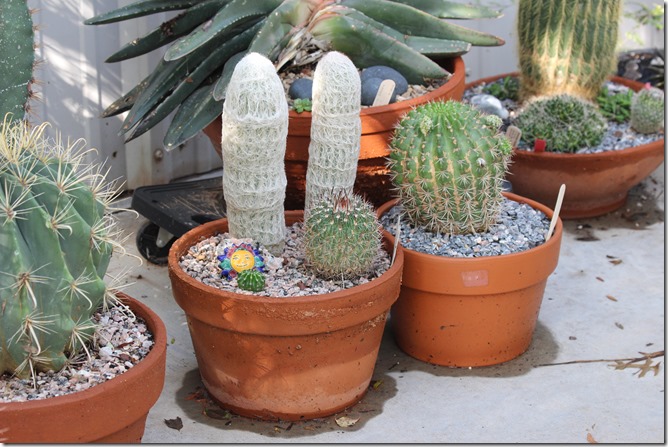
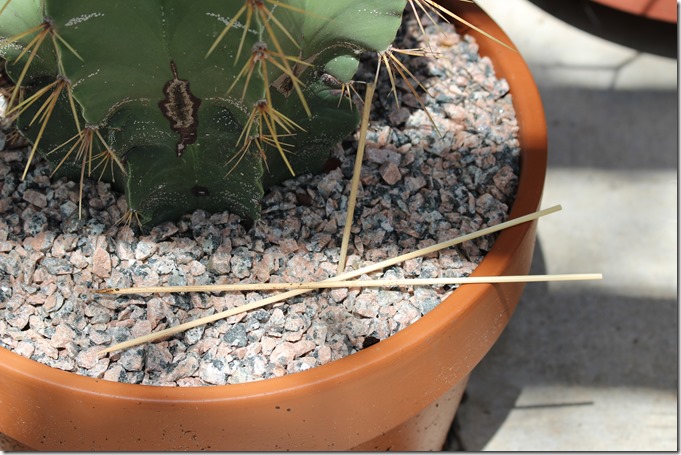
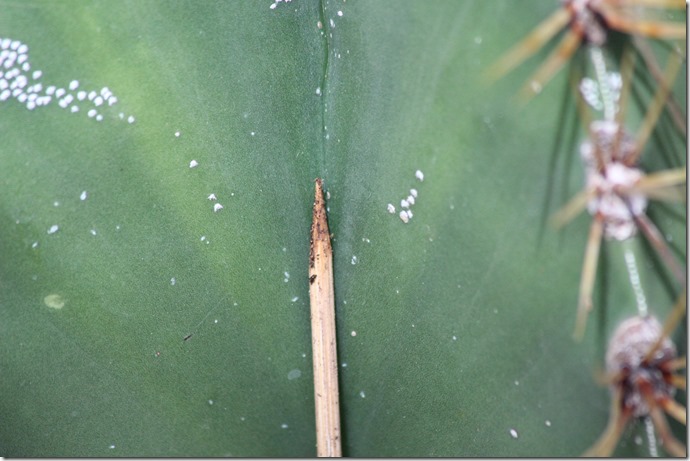
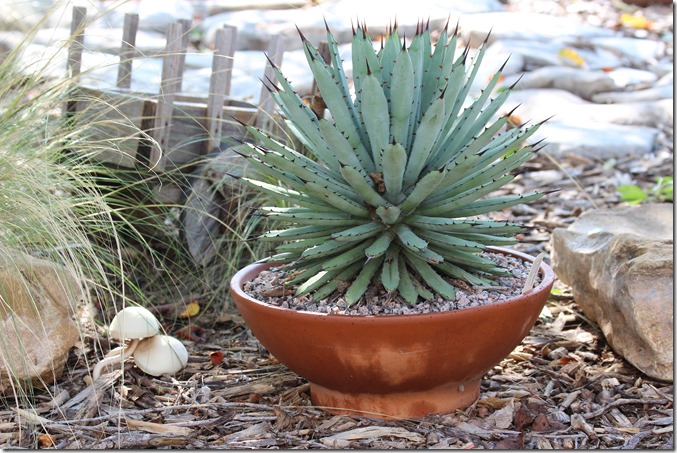
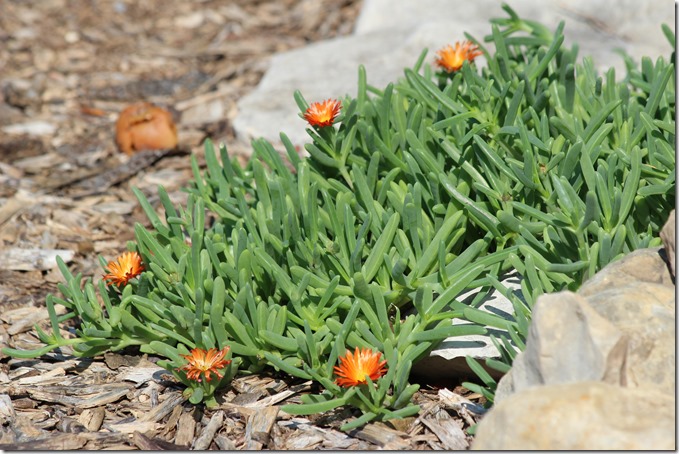
What’s the best stones for the top of the pot between plants.
Ollie, if you are talking about what to use for top dressing for your plants, you have many choices, but what I use is crushed granite that I buy in 80 pound bags from a granite quarry in the Texas Hill Country. I can pick a variety of sizes and colors and really like how it looks and protects the dirt in the pots and keeps it in place. You could use fish gravel you buy for an aquarium, regular pea gravel, crushed glass, and various stone and gravel sold just for the purpose of top dressing at the big box stores. You could also buy bags of polished stones. If you are talking about larger stones to decorate a dish garden with, anything goes. If this doesn’t answer your question, ask again! Thanks for reading.
Thank You so much for your knowledge. It put my mind at ease. I usually bring in all my succulents and cacti from the heavy rain, but this time I left the cactuses out.
They do like rain water, just not sitting in it for days! Thanks for reading.
Is there a recommended zone 7A cactus that tolerates water well? It’s a temperate rain forest here. I have my cactus outside on a sloped gravel bed, with lots of sand. Thanks.
I would think just about any cactus would work for you in zone 7 as long as you don’t let it stand in water for long periods of time, and based on what you said about your sloped gravel bed, you know that! I have been told that too much sand is sometimes not good because it tends to sort of mat up and hardened after drying and isn’t good for cactus roots, so just make sure you don’t have pure sand; mix that gravel with it. Some cactus, like rhipsalis hatiora salicornioides, that actually live in the rain forests, can tolerate more moisture. You might google cacti for zone 7 and see what comes up. You might want to avoid cactus from the really super hot, arid places in the world, since they might be the least likely to tolerate higher moisture. I hope this helps, Thomas.
Tony Avent, owner of Plant Delights Nursery in Wake County, NC pushes the limit in his Zone 7b display gardens. He has a number of cacti he has had luck with for sale. Of course he has ideal conditions for all his garden plants. He has a mail order business, so you can find it all on line. He also has videos and articles on line. He is a renowned plantsman who has traveled to many countries on plant expeditions. His plants are expensive, but his knowledge and advice is free and invaluable.
Thanks for the information, Danese. I hope Thomas sees it.
It helped, but my problem is despite my efforts, some of those cactus advertised by The Cold Hardy Cactus Man, have just literally turned to mush in place, and some have thrived and I don’t know what makes the difference in their survival. They are all listed as zone 6 safe at least, so I know it’s not supposed to be the cold zone I am in, 7A.
Thomas, I am going to the CSSA convention in San Luis Obispo in July and will ask the experts about your problem. I know you said zone 7, but it might be helpful to know exactly where you are located. Check back after July 22 to see if I have come up with anything helpful. Hang in there!
Thanks Alice! I am zone 7A in the mountains, Asheville, NC.
Thanks for sending your location, Thomas. I have my notes and will see what I can find out at the convention.
Thomas, I’m afraid I didn’t get a good answer to your question at the convention. The people I questioned asked for more information about your location even though I told them all that you gave me. I think they were fearful of recommending something and then have it die, too. The best I can do for you is make sure you do have good drainage, don’t water when the weather there has been rainy, and google cactus for wet climates. I even lose cactus in our dry area, so it comes down to trying different ones and seeing what works for you. I know that is not what you wanted to hear since you feel like you are already doing that. I might also suggest you look around and see if there is a cactus/succulent club reasonably close to you and go to some of their meetings. Don’t give up!
All my succulents got a couple days of heavy and not so heavy rain and I’m afraid the soil won’t dry quick enough and also scared that they will get root rot. How long can the soil stay wet or soggy before I need to worry?
It’s really hard to say. It sounds like they are in the ground. If they are in pots, don’t let them stand in water. If they are in the ground, I think you’ll just have to be patient and wait it out. I would think longer than a full week might do some of them in, but, again, it’s hard to know. Some succulents will survive more water than others. In the future, do make sure you add some gravel, pumice, or something else to the soil to provide drainage in future downpours. I fear I haven’t been much help. Good luck.
Thanks for the read Alice.
I’ve recently had to move my growing collection out from shelter and now they are in a makeshift shade house (shade cloth thrown on some spikes) because they are in direct sunlight from 9am until sunset.
I’ve just had my first rainfall since moving the plants and its set for to continue for three days of consistent rain on and off. I live in Adelaide, south Australia and we’ve just come out of a heat wave so the rain is welcome but I have been so worried about root rot and fungus since its three days of rain.
You’ve given me some hope that they aren’t all going to die and go to mush.
I did move some of the littlest plants under shelter but now I’m not as worried about the other.
Wow! A reader from Australia! I certainly hope you don’t lose a bunch of them. About all you can do is let them dry out, make sure they aren’t sitting in water, and then even wait a while before you water them yourself, I guess. Good luck. Hope all goes well. I really don’t have this problem very often here, and we have been especially dry and very cold this winter, and I can tell I can going to lose too many plants in the garden because of it. But maybe not. Sometimes they surprise me and actually come back to life when it warms up. Let me know how it works out.